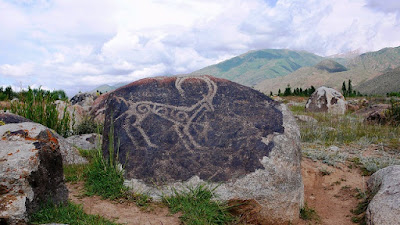The former Soviet republic of Kyrgyzstan is possessed of a great deal of rock art, especially beautiful petroglyphs of ibex. Kyrgyzstan has been known as a land of mounted nomads for pretty much all of recorded history. The people of this region first entered our history under the generic name Scythians. A governmentally approved and published textbook on their history introduces the Kyrgy people this way. “From the eighth to the third century B.C.E. the vast territory of Central Asia was inhabited by numerous nomadic tribes known in ancient Persian cuneiform texts as the Sakas – ‘free men, noble men (warriors).’ They have been known by several names. Ancient writers called them Scythians; in ancient Indian sources they are referred to as the Tur; the Chinese called them the Se People. Individual groups who entered this tribal confederacy had their own names – the term ‘Saka’ was used to refer to all members of this union. Herodotus, ‘the father of history’ wrote about the origins of the Scythians.” (Osmonov and Turdalieva 2016:31)
And Wikipedia gives a short history of them this way. “The history of the Kyrgy people and the land now called Kyrgyzstan goes back more than 3,000 years. Although geographically isolated by its mountainous location, it had an important role as part of the historical Silk Road trade route. In between periods of self-government it was ruled by Gokturks, the Uyghur Empire, and the Khitan people, before being conquered by the Mongols in the 13th century; subsequently it regained independence but was invaded by Kalmyks, Manchus and Uzbeks. In 1876 it became part of the Russian Empire, remaining in the USSR as the Kirghiz Soviet Socialist Republic after the Russian Revolution. Following Mikhael Gorbachev’s democratic reforms in the USSR, in 1990 pro-independence candidate Askar Akayev was elected president of the SSR. On 31 August 1991, Kyrgyzstan declared independence from Moscow, and a democratic government was subsequently established.” (Wikipedia)
An online web site encouraging tourism in Kyrgyzstan gives this introduction to the rock art. “Petroglyphs – pictures drawn or etched onto stones. These drawings, left for us on high rocks and in deep caves can provide evidence of the way of life and the environment of times gone by when there was no system of writing. Rock drawings appear to have been made in two ancient artistic styles. The first technique was silhouette or shadow, typical of many ancient pictures. Blows were made with a metallic or stone instrument to take out the entire surface of the rock nearly 2 mm deep inside the silhouette. Some pictures were beaten by blunt tools which removed only a thin sunburnt rock layer, and this is typical of later periods. Another technique used tools with sharp edges and frequent blows with these produce a deep line engraved in the rock. It is probably incorrect to think that ancient people only depicted the animals that they hunted. Many scholars think that the rock drawings depict mythological images and that the consciousness of ancient painters was restricted by their knowledge of the surrounding nature and society.” (Kyrgyzstravel)
A statement as simplistic and imprecise as the preceding quote illustrates a considerable lack of knowledge on the subject, yet also indicates enthusiasm and interest in the subject. The fact is that Kyrgyzstan is possessed of a great deal of beautiful rock art, especially the aforementioned images of ibex. Probably a common quarry of Kyrgy hunters.
Another prolific petroglyph site is Saimalu Tash – “(meaning ‘embroidered’ or ‘patterned stones’ in Kyrgyz) is a petroglyph site in northern Jalal-Abad Province, south of Kazarman. Over 10,000 carved pictures which are black-and-white rock paingings, have so far been identified, making the site a globally important collection of rock art.” (Miner 2018)
Sites in
Kyrgyzstan contain a broad range of rock art images, from zoomorphs and
anthropomorphs to abstract designs. In this particular column it has been my
intention to primarily focus on the beautiful ibex petroglyphs.
Kyrgy hunters depended on their horses, on a highly prized breed of sight-hound dogs known as Taigan, and Golden Eagles. The hunting of ibex would have no doubt been accomplished with their bows and arrows, but smaller game such as foxes, rabbits, marmots, etc., were hunted with the golden eagles. Among the beautiful photographs of ibex petroglyphs that I found was also a petroglyph that I identified as an Eagle Hunter.
More on the Eagle Hunter in part 2 of this column.
NOTE: Images in this posting were retrieved from the internet with a search for public domain photographs. If any of these images are not intended to be public domain, I apologize, and will happily provide the picture credits if the owner will contact me with them. For further information on these reports you should read the original reports at the sites listed below.
REFERENCES:
Miner, Mark E., 2018, Petroglyphs in Kyrgyzstan, 13 September 2018, https://silkroadresearch.blog/, accessed on 14 October 2021.
Kyrgyzstantravel, Petroglyphs - Rock Art, accessed on 7 November 2021, https://www.kyrgyzstantravel.net/culture/petroglyphs.htm, accessed on 14 October 2021.
Osmonov, Oskon, and Cholpon Turdalieva, 2016, A History of Kyrgyzstan, From Stone Age to the Present, school and university textbook, Ministry of Education and Science of the Kyrgyz Republic, Bishkek.
Wikipedia, History of Kyrgyzstan, accessed on 9 November 2021, https://en.wikipedia.org/wiki/History_of_Kyrgyzstan











No comments:
Post a Comment